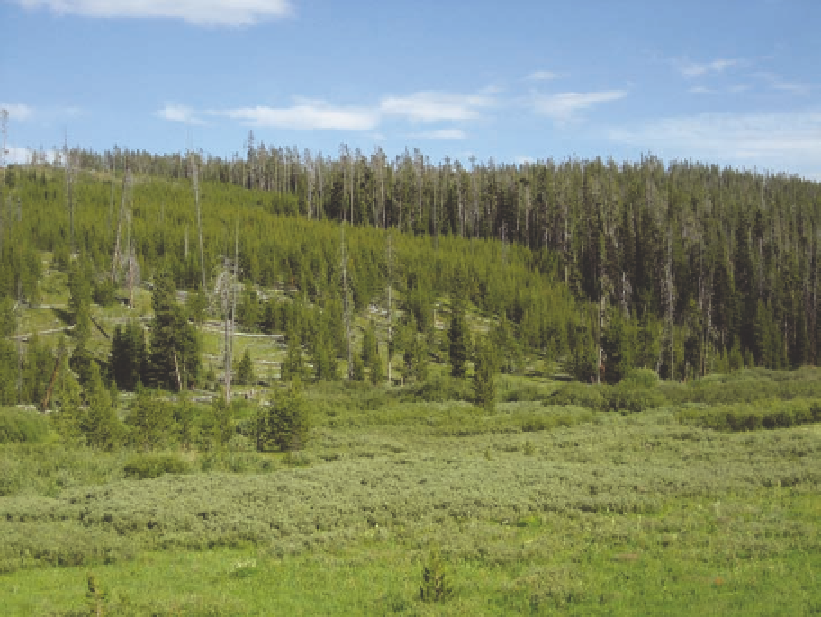Geoscience Reference
In-Depth Information
Fig. 11.14. Lodgepole pine forests along the Rockefeller
Parkway between Yellowstone and Grand teton national
parks. the stand on the left originated after the fires of 1988,
24 years before this photo was taken. the young trees are
very dense, because many of the pre-fire trees had seroti-
nous cones, and also because the conditions for seedling
establishment during the two years after the fire were
favorable. the stand on the right has not burned for more
than 250 years. Many of the dead trees visible in the older
stand have been killed by mountain pine beetles during the
past 10 years. A riparian meadow and shrubland are in the
foreground.
availability, even without a canopy gap, but so does the
chance of spruce and fir establishment.
Usually fires in lodgepole pine forests are infrequent,
separated by many decades or centuries in any given
stand. this is primarily because of the cool, relatively
moist environments inhabited by lodgepole pine,
where snow persists until late spring and frequent sum-
mer rain showers commonly keep fuels too wet to sup-
port extensive fire in most years. only in exceptionally
dry years do large fires occur in lodgepole pine forests.
Under these conditions, fires tend to be severe and
stand-replacing, often burning over large areas.
69
in contrast to ponderosa pine and Douglas-fir, lodge-
pole pine trees have thin bark and are easily killed by
even low-intensity fires. However, lodgepole is well
adapted as a species, if not as individuals, to a high-
severity fire regime because of its ability to produce
serotinous cones (figs. 11.14 and 11.15). these cones are
produced more or less continuously, but they remain
closed and on the tree for many years until higher than
usual heat causes the cone scales to open, such as dur-
the forest floor if they are exposed to the sun for a long
the treetops as the forest develops. Most of the seroti-
nous cones open following a fire, and the seed is dis-
persed by wind at a time when a mineral soil seedbed
and low competition for resources help to ensure seed-
ling survival. At such times, more than a hundred thou-
sand seeds may be dispersed per acre in a single year.
72
interestingly, not all lodgepole pine trees produce
serotinous cones. individual trees tend to have either all
serotinous or all nonserotinous cones, though a few trees
trees in stands of lodgepole ranges from 0 to nearly 100
percent, with the highest proportions in young stands
at lower elevations, where the last major disturbance
was fire. the lowest proportions are in older stands at

Search WWH ::

Custom Search